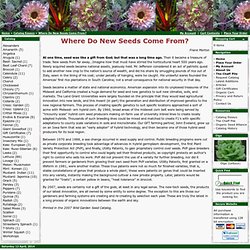

Achillea millefolium 'Cerise Queen' seeds. Helianthus angustifolius (Swamp sunflower. Native Wildflower Seed and Potted Plant Price List. Dame's Rocket Seeds for sale - 2,000 seeds/$1.99 - Hesperis matronalis Seeds - Perennial Flower Seeds. Hesperis matronalis Wonderfully fragrant flowers at night Flowers attract butterflies, hummingbirds and moths Easy to grow in sun or light shade This old-fashioned, cottage garden plant produces rounded clusters of violet flowers that are similar to stock and are wonderfully fragrant at night.

Grows 2-3 feet tall. Easy to grow from seed. Often self-sows. Dame's Rocket seeds cannot ship to CO, CT, MA, NH, or WI. Hesperis matronalis A beautiful blend of violet and white fragrant flowers on easy to grow 2-3 foot plants. Dame's Rocket cannot ship to CO, CT, MA, NH, or WI. How to Plant DAME'S ROCKET Seeds Direct sow into prepared seed beds that have been cleared of weeds and have had the top 1 inch of soil loosened. 10 Tips on Dividing Perennial Plants. Timing is important by Todd Meier When dividing perennials, timing and technique are important.

And while many perennials can be divided in either early spring or early fall, some are very picky. The optimal time to divide specific perennials is denoted by (S) for spring and (F) for early fall. Early Snow Glories. Peruvian Red Verbena. Discovery Dutch Iris. Golden Bells Carpet Daffodils. Lavender Mountain Lilies. Dwarf Burning Bush. Cappucino Gloriosa Daisy. Walters Gardens, Inc. : Timing Chart. Wildflower Seed Wholesale Supplier. Terraced Garden Ideas. Terraces can increase the usability of a hill for gardening.

By gardening in terraces, you can grow virtually any flower or vegetable normally associated with flat ground gardening. If you are designing your terraces from scratch, be sure to design them with adequate access space for garden maintenance and harvesting. If you can, design in a water drainage system that routes excess water on upper terraces down to lower terraces. Flowers When planting flowers in a terraced garden, use the differing heights of the beds to help create a vertical wall of color.
Vegetables. Problem solving Plants for Slopes & Banks. Often driving thru older neighborhoods, you'll often see homes several feeter higher than the sidewalk with a bank gradually sloping down to street level.

This is a a challenging site to grow plants. Water runs off quickly rather than soaking in often leading to erosion. A steep slope may need to be reworked by terracing or creating a retaining wall. For gradual slopes, planting groundcovers is a cost effective solution for dealing with these problem areas while stabilizing the soil, reducing maintenance while turning a negative eyesore into a gorgeous front yard.
They key to making this work is using certain groundcovers that form a solid, soil-holding mass quickly. A favorite and adaptable groundcover is Ajuga Chocolate Chip with persistent, fast spreading roots. Creeping Sedums are some of the most versatile plants that take hold effortless in dry soil and one of my personal favorites. Other groundcover considerations: A Slope/Bank Garden. Growing Uphill... We've seen it endless times, especially in new subdivisions. All the topsoil removed for house foundations or removing trees leave a rising bank of dirt on either side of the driveway, or down one side of the yard.
Or perhaps the property was once a ravine or built on a slope, but the plants that held the bank up are long gone. Without expensive terracing using timbers and stone walls, the bared earth will erode. Setting flagstones at an angle starting along the base of such a slope, and then working up in rows can be effective - especially if inter-planted with plants and shrubs with strong fibrous root systems. Common daylilies will handle gradual slopes - and this is the wild daylily (hemerocallis fulva) not one of the popular, but puny in comparison, cultivars. Shou Sugi Ban Japanese burnt timber decking channel 5 Garden ER - The Decking Network. CHANNEL 5's GARDEN ER asked us to burn the decking so we did Shou-Sugi-Ban - Burnt Sugi Boards 焼杉板 Exterior decking not only provides the industry with decking and cladding, they are sometimes required to provide something that little bit special.

Having researched for more techniques to achieve different finishes on timber decking and cladding we decided to use the Shou-Sugi-Ban technique. Planting Guide. Growing Collard Greens, Planting Collard Greens, How to Grow Collard Greens. Learn how easy it is growing collard greens in your backyard vegetable garden.

Design Your Own Vegetable Garden Layout Using our Free "Vegetable Garden Planner" Software! Learn how to plant, care for, and harvest for collard greens when gardening. Also we offer easy tips on how to freeze and pressure can extra collard greens harvested from your garden. Download Free Garden Planning Worksheets, Garden Diary, Zone Chart, Or Planting Guide. Www.usefulplants.org/2008-upn.pdf. Mountain Meadows Dwarf Conifers Nursery Home page. Garden Center in Asheville, Weaverville, & Western North Carolina - Reems Creek Nursery, Inc.
Plant Inventory. Plants, Bulbs & Seeds for Growers & Grower Supplies. Environmental Seed Producers. Heirloom Vegetable Seeds from Victory Seeds® Growing Amaranth and Quinoa. Recipes There are so many similarities between quinoa (keen' wah) and amaranth that it seems appropriate to describe them together.

Quinoa, however, is a cool weather crop and amaranth is a warm weather one. Quinoa and amaranth are two very old, high-protein plants that hail from South America. They were held sacred in ancient Inca and Aztec cultures. Both now hold great potential for self-sustaining gardens in the northern hemisphere. Quinoa and amaranth are treated as grains although they have broad leaves, unlike the true grains and corn, which are grasses. Wild Garden Seed: Where Do New Seeds Come From? Frank Morton At one time, seed was like a gift from God; but that was a long time ago.

Then it became a treasure of trade. New seeds from far away...Imagine how that must have stirred the horticultural heart 500 years ago.